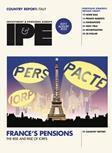GLOBAL – Fire safety risks are persistent across industry sectors and geographies, causing major concerns for companies and investors alike, according to research by responsible supply chain specialist Sedex and labour standards NGO Verité.
The research finds that fire safety comprises 32% of health and safety failings in global supply chains, with key risks identified in both developed and emerging markets.
In Europe, 13.5% of supply chains fail to comply with safety measures, compared with 6.6% in Africa.
The top five most prevalent fire safety risks identified at supplier sites across the world include missing or inadequate exit signage and functioning emergency lighting, blocked aisles and fire exits and inadequately installed or missing fire fighting equipment.
At the sector level, manufacturing and pharmaceutical sectors have the highest level of fire risk globally, while agricultural companies, which are particularly predominant in Africa, had the lowest.
Asia, which has seen serious factory fires in both Bangladesh and Pakistan in the past year, shows 12.7% non-compliance compared with 11% in North America and 11.8% in South America.
The briefing provides an overview of the type of actions purchasers and suppliers can take to improve the safety of factories, with a focus on risk and performance management.
These include measures that are planned for during the design and construction of a building, as well as systems for fire protection, building maintenance, emergency response and personnel training.
Other insights from Sedex and Verité include a spotlight on Bangladesh to provide a broader context on some of the political, economic and cultural root causes of fire safety non-compliances and the complexities involved in finding sustainable solutions.
The Fire Safety Risk Briefing is available here.
In other news, five years on from the collapse of Lehman Brothers, Guy de Blonay, manager of the Jupiter Financial Opportunities Fund, has said banks are now largely fit-for-purpose.
"Some of the key milestones that helped improve the sector include the passing of the Dodd Frank Act in 2010 that gave to the Federal Reserve tough new powers over US banks, Basel III rules in the same year that forced global banks to adopt stricter capital and liquidity requirements and, in Europe, a political will to implement cross-border oversight of the sector with the creation of the European Banking Authority in 2011."
He also cited "sweeping changes" to the way banks are supervised in the UK and new legislation that will see retail banking ring-fenced from investment banking activities."
De Blonay said: "The Federal Reserve signalled its renewed confidence in the sector as early as March 2011 when it allowed leading US banks to start paying dividends again and buying back stock.
"With most banks now well capitalised, we can expect a growing number of them to boost the amount of cash they return to shareholders, and for some of them to resume paying dividends.
"Regulators, however, still have to deal with the tricky issue of banks that are too big to fail while global imbalances fuelled by years of low interest rates remain a concern."
Meanwhile, emerging markets private equity fund manager LeapFrog Investments has raised $204m (€154m) at the first close of its second fund.
Investors include six insurers – Achmea, Met Life, PartnerRe, Prudential, Swiss Re and XL Group – as well as global banks and asset managers including Christian Super, JP Morgan Chase and TIAA-CREF and development finance institutions.
LeapFrog's second fund will continue to focus on making investments in insurance and financial services companies in eight developing markets in Africa and Asia by targeting the emerging consumer demographic – the 1.9bn consumers living on incomes between $2 and $10 a day, the vast majority of whom want, but lack access to, financial services.
The new fund aims to make equity investments of up to $60m.





























No comments yet